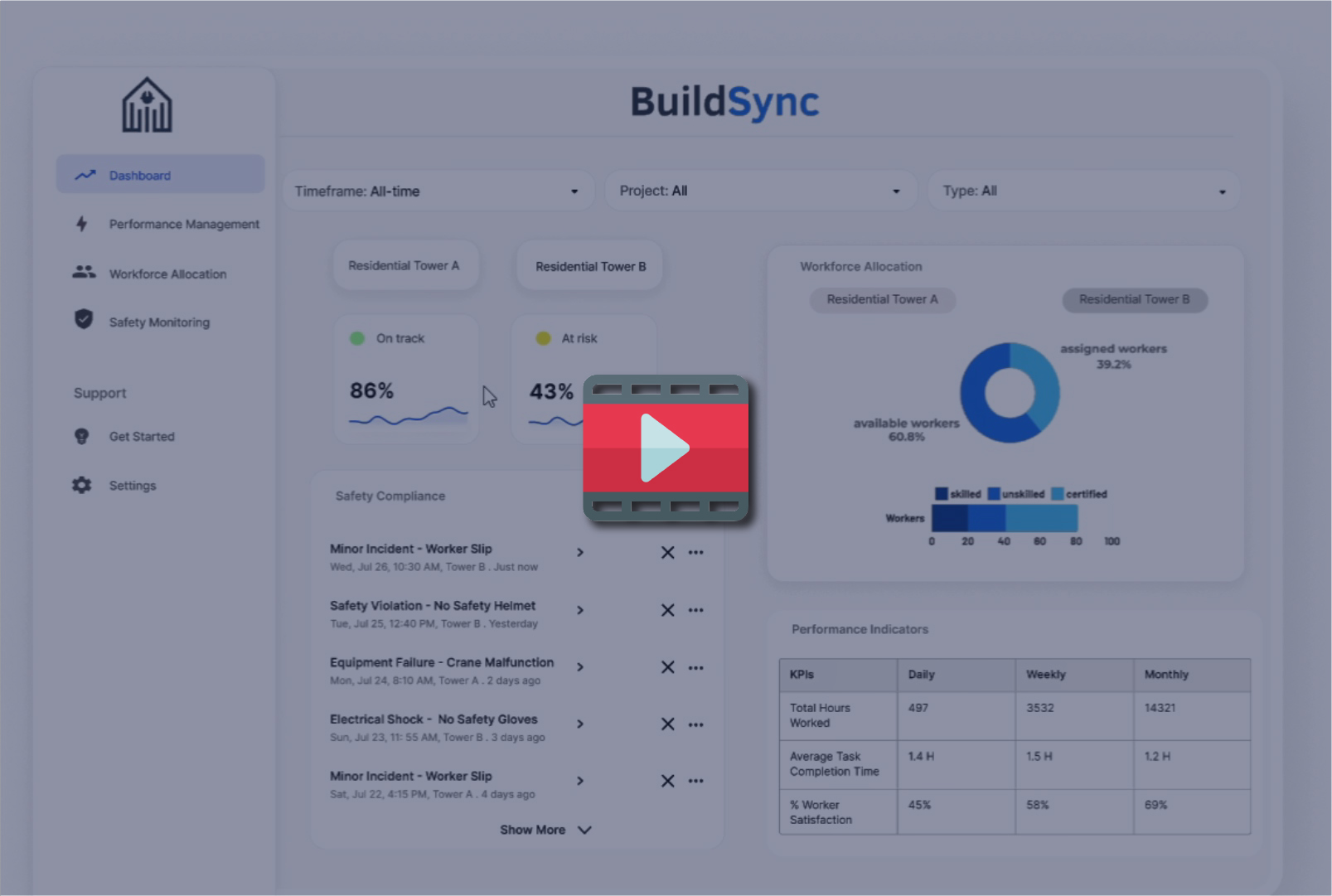Introduction
In an industry that is as hands-on and physically demanding as construction, the rapid rise of digital tools may seem paradoxical. However, digital innovation is proving to be a game-changer for construction companies worldwide, allowing them to enhance productivity, streamline processes, and address some of the sector’s most significant challenges, including workforce shortages, safety compliance, and cost overruns. At the core of these advancements is workforce management—a critical area that stands to benefit immensely from digital transformation.
In this article, we’ll explore how digital innovation is shaping the future of workforce productivity in construction, the challenges the industry faces, and the essential digital tools that can help construction firms thrive.
The Challenges Facing Construction Workforce Productivity
- Labor Shortages
With many skilled workers reaching retirement age and fewer younger workers entering the construction field, companies are grappling with an ongoing labor shortage. According to a recent survey, the construction industry could be short by hundreds of thousands of workers over the coming decade. The scarcity of skilled labor increases the workload on available workers, often leading to project delays and compromised quality. - Project Complexity and Management
Modern construction projects are more complex than ever. They often require coordination between various subcontractors, adherence to strict timelines, and compliance with multiple safety regulations. Without effective workforce management, keeping teams organized and projects on track becomes nearly impossible. - Safety and Compliance Issues
The construction industry has always had a higher-than-average rate of workplace injuries, and failing to comply with safety regulations can lead to costly shutdowns and even loss of life. Workers need consistent safety reminders and real-time updates on hazards to stay protected, which can be challenging to manage manually. - Cost Overruns and Delays
Inefficiencies in workforce management, from overstaffing and understaffing to lack of oversight, contribute to project delays and cost overruns. This can cause severe financial strain, especially for companies operating on tight margins. Digital tools can offer the real-time insights needed to optimize team allocation, manage tasks efficiently, and minimize downtime.
How Digital Innovation is Transforming Workforce Productivity in Construction
Digital tools, such as mobile apps, cloud-based platforms, and workforce management software, are driving the construction industry toward a more productive and resilient future. Here are some of the most impactful ways these tools are changing workforce productivity:
- Real-Time Task Management and Communication
With mobile apps designed for workforce management, companies can assign tasks and send real-time updates to their teams, whether they’re on-site or in the office. This improves communication and helps workers respond to changes instantly, keeping projects running smoothly. - AI-Driven Workforce Scheduling
While many construction projects still use manual scheduling methods, AI-driven tools can allocate workers based on skills, availability, and project needs. This not only optimizes labor use but also reduces the risk of delays due to understaffing or misallocated resources. By ensuring the right worker is in the right place at the right time, companies can prevent common inefficiencies and keep projects moving forward. - Digital Training and Compliance Tracking
Digital platforms now offer online training modules that allow workers to access important safety and compliance information directly from their devices. Real-time safety alerts and compliance updates also keep workers aware of current hazards, reducing the likelihood of accidents on-site. This proactive approach ensures a safer work environment while minimizing disruptions due to non-compliance. - Progress Tracking and Data Analytics
Monitoring project progress is critical for assessing workforce productivity. Digital tools now provide supervisors with real-time data on task completion, hours worked, and project timelines. Data analytics allow managers to identify bottlenecks, track worker performance, and make adjustments as needed. Over time, this data can also reveal trends, helping companies improve planning for future projects. - Streamlined Recruitment and Onboarding
The hiring and onboarding process can be lengthy, especially in a competitive labor market. Digital platforms can simplify recruitment by allowing managers to view a list of candidates, track their skills, and hire directly from a centralized system. Digital onboarding tools also reduce the time and paperwork needed to bring new hires up to speed, allowing them to get started on projects faster.
Benefits of Adopting Digital Workforce Management Tools
The shift to digital workforce management tools offers construction companies a host of tangible benefits:
- Enhanced Productivity
By automating repetitive tasks and improving communication, digital tools enable workers and managers to focus on high-value tasks. This boosts overall productivity, allowing teams to complete projects faster and more efficiently. - Improved Worker Satisfaction
Having clear objectives, real-time updates, and access to safety resources creates a more structured and supportive work environment. This can lead to higher job satisfaction, which ultimately benefits the company by reducing turnover and creating a more engaged workforce. - Greater Transparency and Accountability
Digital tools provide real-time visibility into task progress, worker availability, and project timelines. This transparency fosters accountability among team members, encouraging them to stay on task and take ownership of their responsibilities. - Reduced Operational Costs
By minimizing delays and optimizing workforce allocation, companies can significantly reduce costs associated with labor and project overruns. Digital tools can help identify cost-saving opportunities and mitigate financial risks. - Enhanced Safety Compliance
Safety is always a priority in construction, and digital tools help ensure workers adhere to safety protocols. By integrating training, alerts, and compliance tracking into a centralized platform, companies can reduce workplace accidents and avoid costly violations.
Overcoming Barriers to Digital Transformation in Construction
While digital innovation has the potential to revolutionize workforce productivity in construction, there are challenges to adoption:
- Cost of Implementation
The initial cost of digital tools can be a barrier for some companies, particularly small- and medium-sized businesses. However, many digital platforms offer scalable solutions that allow companies to start with essential features and expand as needed. - Resistance to Change
Some workers and managers may resist new technologies, especially if they’re used to traditional methods. To overcome this, companies can provide training and support to ease the transition and demonstrate the benefits of digital tools. - Data Security and Privacy Concerns
Handling sensitive worker data requires a secure system. Construction firms must ensure they select platforms with strong data security measures to protect employee information and maintain compliance with regulations. - Skills and Training
The successful use of digital tools requires basic digital literacy. Companies may need to invest in training to ensure workers can navigate new technologies confidently and make the most of the available features.
The Future Outlook: Building a Digitally-Enabled Construction Workforce
As the construction industry continues to evolve, embracing digital workforce management solutions will be essential to building a more productive, efficient, and resilient industry. While some companies are already reaping the benefits of digital transformation, many are still in the early stages. As these technologies become more affordable and accessible, we can expect to see digital tools playing an increasingly important role in construction.
Ultimately, the future of construction lies in a blend of skilled labor and cutting-edge digital innovation. Companies that invest in workforce management tools today will be better positioned to handle the demands of tomorrow, delivering projects faster, safer, and with greater precision. Digital transformation is no longer a luxury; it’s a necessity for companies looking to thrive in the modern construction landscape.
Conclusion
The shift toward digital workforce management is not just a trend—it’s a necessary step forward for the construction industry. By leveraging digital tools for scheduling, communication, safety, and recruitment, companies can enhance productivity, improve worker satisfaction, and reduce costs. As the technology continues to advance, construction firms have an opportunity to build a more efficient and resilient workforce, setting the stage for a stronger, more innovative future in construction.



